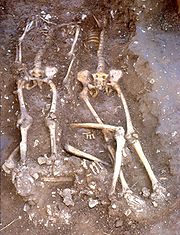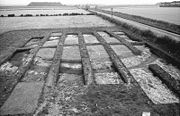
Walkington Wold Burials
Encyclopedia

East Riding of Yorkshire
The East Riding of Yorkshire, or simply East Yorkshire, is a local government district with unitary authority status, and a ceremonial county of England. For ceremonial purposes the county also includes the city of Kingston upon Hull, which is a separate unitary authority...
are the skeletal remains of 13 individuals from the Anglo-Saxon
Anglo-Saxons
Anglo-Saxon is a term used by historians to designate the Germanic tribes who invaded and settled the south and east of Great Britain beginning in the early 5th century AD, and the period from their creation of the English nation to the Norman conquest. The Anglo-Saxon Era denotes the period of...
period, discovered in the late 1960s. Subsequent examinations have concluded that they were decapitated Anglo-Saxon criminals, the only such burial discovered in Northumbria
Northumbria
Northumbria was a medieval kingdom of the Angles, in what is now Northern England and South-East Scotland, becoming subsequently an earldom in a united Anglo-Saxon kingdom of England. The name reflects the approximate southern limit to the kingdom's territory, the Humber Estuary.Northumbria was...
.
Original excavation

Archaeology
Archaeology, or archeology , is the study of human society, primarily through the recovery and analysis of the material culture and environmental data that they have left behind, which includes artifacts, architecture, biofacts and cultural landscapes...
Rod Mackey and John Bartlett discovered the burials while excavating the Bronze Age
Bronze Age
The Bronze Age is a period characterized by the use of copper and its alloy bronze as the chief hard materials in the manufacture of some implements and weapons. Chronologically, it stands between the Stone Age and Iron Age...
barrow
Tumulus
A tumulus is a mound of earth and stones raised over a grave or graves. Tumuli are also known as barrows, burial mounds, Hügelgrab or kurgans, and can be found throughout much of the world. A tumulus composed largely or entirely of stones is usually referred to as a cairn...
at Walkington Wold, about 2 km west of the Yorkshire village of Walkington
Walkington
Walkington is a village and civil parish in the East Riding of Yorkshire, England. It is situated approximately to the south west of the town of Beverley on the B1230 road.The civil parish is formed by the village of Walkington and the hamlet of Broadgate...
, from 1967 to 1969. The site was known in local folklore as Hell’s Gate. Twelve skeletons were unearthed, ten without heads, as well as eleven crania. All were buried randomly, the crania well away from the bodies. Some of the crania were found at the centre of the barrow mound, while the bodies were all located at its skirt. Theories of their identity included victims of a late Roman masacre, Anglo-Saxon executions, or even a Celtic head cult.
Re-evaluation
The skeletons were re-examined by archaeologists Jo Buckberry from Bradford University and Dawn Hadley from Sheffield University (Buckberry & Hadley, 2007). It was revealed that 13 individuals were unearthed in the late 1960s, all males between 18 and 45. According to radiocarbon datingRadiocarbon dating
Radiocarbon dating is a radiometric dating method that uses the naturally occurring radioisotope carbon-14 to estimate the age of carbon-bearing materials up to about 58,000 to 62,000 years. Raw, i.e. uncalibrated, radiocarbon ages are usually reported in radiocarbon years "Before Present" ,...
the remains range from as early as the mid-seventh to as late as the early eleventh centuries. Examination of the skeletons revealed that their owners were subjected to judicial execution by decapitation, one of which required several blows. Furthermore, the heads were probably displayed on poles as warnings to others. This was a known practice in Anglo-Saxon England. The burial site is ideally situated for public display on a rise by a road. The absence of jawbones from most of the skulls suggests that they fell off as the heads decomposed on the poles.
The crimes of the men are unknown, owing to the lack of any associated documentation. The burial site is between the defunct village of Hunsley and Walkington, at the boundary of the hundreds of Welton and Cave. The use of an ancient barrow site situated on the boundaries between communities indicates that the executed were excluded from the community, even in death. The name Hell’s Gate may be a memory in local folklore of the site of the executions and head poles (Mackey, 2006).
Significance

Humber
The Humber is a large tidal estuary on the east coast of Northern England. It is formed at Trent Falls, Faxfleet, by the confluence of the tidal River Ouse and the tidal River Trent. From here to the North Sea, it forms part of the boundary between the East Riding of Yorkshire on the north bank...
. It is one of the few such sites excavated recently, using modern methods of reporting and preservation. The site contributes to evidence that such execution cemeteries were in use over a long time, being established long before their first documentation in the tenth century (Hadley & Buckberry, 2005: 130), as well as that men, rather than women, tended to be executed for crimes in late Anglo-Saxon England. It also shows a continuity over a period which includes the upheavals of Danish invasion and settlement
Danelaw
The Danelaw, as recorded in the Anglo-Saxon Chronicle , is a historical name given to the part of England in which the laws of the "Danes" held sway and dominated those of the Anglo-Saxons. It is contrasted with "West Saxon law" and "Mercian law". The term has been extended by modern historians to...
.
The selection of a Bronze Age barrow for the burials fits a pattern of Anglo-Saxon re-use of ancient barrows and mounds. Such barrows were thought to the be the haunt of dragons
Dragon
A dragon is a legendary creature, typically with serpentine or reptilian traits, that feature in the myths of many cultures. There are two distinct cultural traditions of dragons: the European dragon, derived from European folk traditions and ultimately related to Greek and Middle Eastern...
, goblins
Goblin
A goblin is a legendary evil or mischievous illiterate creature, a grotesquely evil or evil-like phantom.They are attributed with various abilities, temperaments and appearances depending on the story and country of origin. In some cases, goblins have been classified as constantly annoying little...
and the like, and the executed criminals at Walkington Wold, excluded from normal human society by their criminal activity and subsequent executions, were made outcasts in death by their association with such spirits.(Semple, 1997: 111)
Further reading
- Bailey, G.B. 1985. "Late Roman Inland Signal Station, or Temple? Functional Interpretation at Walkington Wold." Yorkshire Archaeological Journal 57, 11-14.
- Bartlett, J.E. & Mackey, R.W. 1973. "Excavations at Walkington Wold, 1967-1969." East Riding Archaeologist 1(2), 1-100.
- Buckberry, J. L. 2008. "Off with their heads: The Anglo-Saxon execution cemetery at Walkington Wold, East Yorkshire". In E. Murphy (ed.) Deviant burial in the archaeological record. (Oxford: Oxbow), 148-168
- Reynolds, A. 1997. "The Definition and Ideology of Anglo-Saxon Execution Sites and Cemeteries" in De Boe, G. & Verhaege, F. (eds) Death & Burial in Medieval Europe (Zellick: Instituut voor het Archeologisch Patrimonium), 33-41.
External links
- Angelika Franz, “Das Geheimnis von Hell's Gate” Spiegel Online (accessed 16 January 2008) – German language, includes image gallery.
- Web sites of Dr Jo Buckberry and Dr Dawn Hadley.

